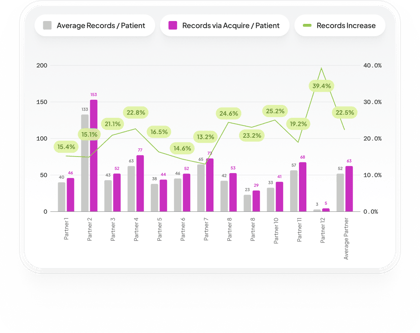Health Data as the Key to Achieving the Triple Aim: 3 Goals for Healthcare in 2024

In 2008, the Institute for Healthcare Improvement introduced a game-changing concept: the Triple Aim framework. This blueprint for healthcare reform set out three primary goals: transform the patient experience, improve population health, and reduce the per capita cost of healthcare.
These three objectives are still guiding the healthcare industry in 2024, but turning these ideals into reality remains a challenge. The key to bridging the gap? Health data—specifically, digitized, readable, and accessible medical records.
In this blog, we’ll explore how health data can drive success in each area of the Triple Aim, and how Credo is working behind the scenes to help make this possible.
What is the Triple Aim Framework?
The Triple Aim framework was designed to tackle the biggest challenges in healthcare by promoting a balanced approach to improving the system. Here’s what the framework aims to achieve:
- Better Patient Experience: Improve the quality of care and patient satisfaction.
- Better Population Health: Enhance the overall health of communities.
- Lower Costs: Make healthcare more affordable by reducing unnecessary expenses.
The framework’s relevance today is undeniable. Healthcare systems are still grappling with inefficiencies, disparities in care quality, and rising costs, including an projected increase in costs by about 8.9 percent in 2024.
Though two additional goals—improving healthcare providers' work-life balance and advancing health equity—have been added to the framework, the original three remain the foundation. This post will zero in on these core objectives, with a particular focus on the role health data plays in achieving them.
Transforming the Patient Experience
Imagine how much your patient interactions would change if you could walk into each appointment with a full understanding of the patient’s medical history. Instead of spending the entire visit asking about their diagnoses, medication history, and past treatments, you could focus on delivering the informed, quality care they need right now.
Not only does access to a pre-encounter medical history make providers’ jobs easier, but patients also are more likely to feel understood and well-cared for when they can tell that their doctor knows who they are and what they’ve experienced.
Credo is working to make this future a reality with our pre-encounter record analysis and summary solution PreDx. Our product delivers digitally accessible, readable, medical records before a patient’s first visit, enabling healthcare providers to deliver more efficient and effective care.
Improving Population Health
When healthcare providers have a clear understanding of their patients’ health histories, they can identify patterns, close care gaps, and implement preventive measures more effectively.
A case study by Wakely Consulting Group, for instance, found that using Credo’s data systems led to an average risk score increase of 0.445 under the HCC-CMS V24 model and an increase of 0.286 under the HCC-CMS V28 model. These figures indicate that more diagnoses are being accurately documented and subsequently treated for each patient, leading to better health outcomes.
When medical records are complete and accurate, healthcare providers can make more informed decisions, which is essential for managing chronic conditions and preventing disease progression. This, in turn, contributes to the overall health of the population and aligns with the goals of the Triple Aim.
Reducing Healthcare Costs
Managing medical records is an expensive process, costing the U.S. healthcare system a staggering $100 billion annually. However, digitized and accessible records can significantly reduce these costs — an outcome Credo’s PreDx is designed to achieve through an efficient, end-to-end patient data solution.
Here’s how PreDx works:
- Streamlined Operations: PreDx retrieves records for patients 98.5% of the time, reducing the need for phone calls and faxes. This streamlines operational workflows, saving time and reducing costs, while also allowing clinicians to focus more on patient care rather than administrative tasks.
- Error Reduction: Manual chart retrieval processes are prone to errors, which can lead to costly medical mistakes or delays in care. PreDx ensures that healthcare providers receive accurate and up-to-date patient information, reducing the risk of errors and the financial repercussions that come with them.
- Reducing Redundancies: PreDx connects seamlessly with various data sources to provide a comprehensive view of a patient’s health history, which includes all evidence-based suspect HCCs. This not only reduces the time spent chasing down records but also lowers the costs associated with duplicate tests and unnecessary follow-up visits.
Ready to see how PreDx can transform your practice? Schedule a demo today.
The Path Forward for Medical Record Retrieval and Analysis
The Triple Aim framework continues to guide the evolution of healthcare, but achieving its goals requires more than just a good plan.
Health data—specifically digitized, readable, and accessible medical records—is the key to unlocking the full potential of the Triple Aim. But it’s not so easy.
As we continue to focus on transforming the patient experience, improving population health, and reducing costs, it’s important that every health system is given the ability to easily access the data they need. Credo’s mission is to make this possible in order to fully align U.S. healthcare with the Triple Aim.
Back to blog




